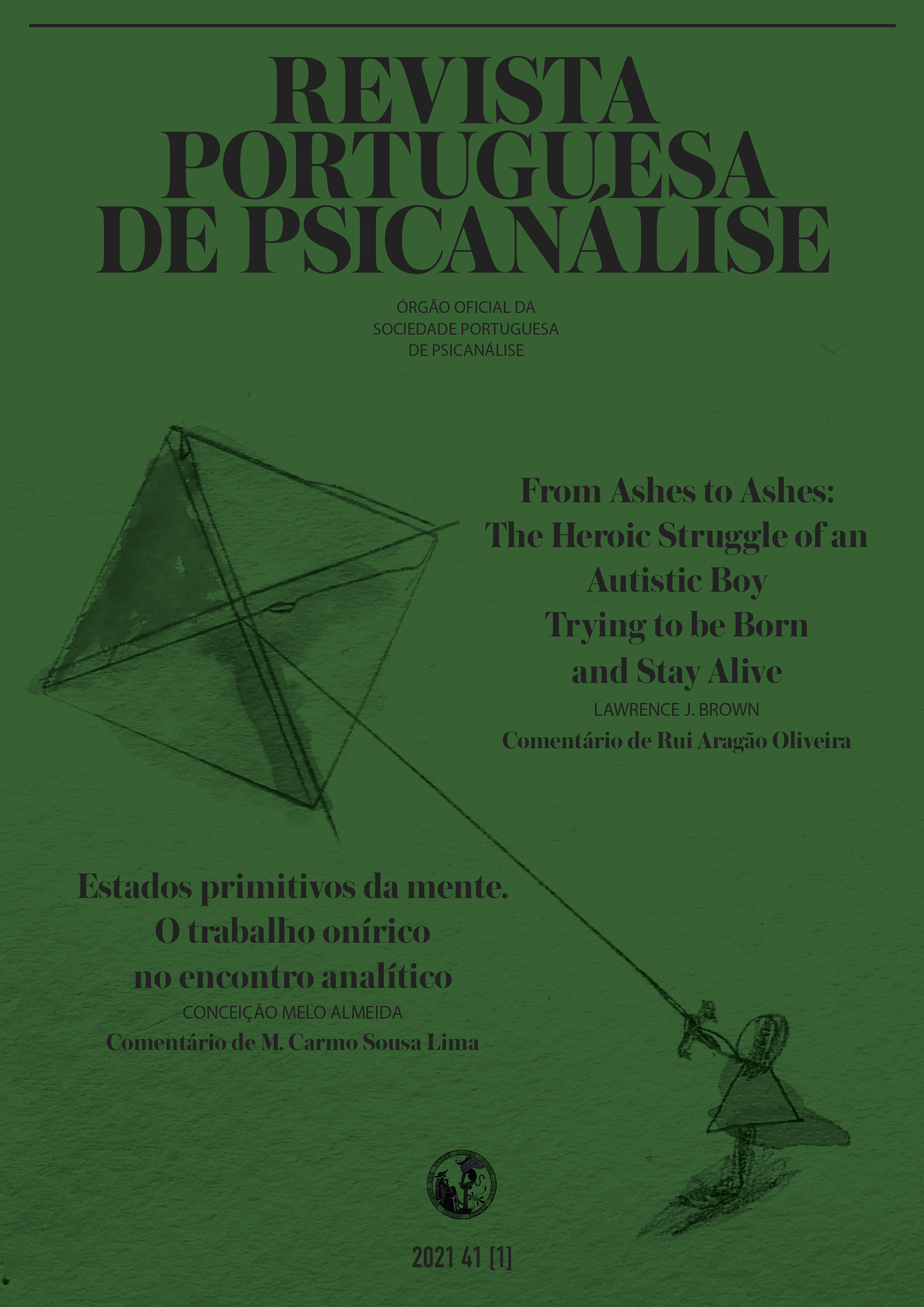From Ashes to Ashes: The Heroic Struggle of an Autistic Boy Trying to be Born and Stay Alive

Resumen
This paper investigates the concept of psychogenic autism that has been proposed by Frances Tustin. Her work centers on the dynamics of this serious illness with an emphasis on the infant’s experiences in the earliest connection with the mother. Tustin writes that the sudden and violent disruption of the skin-to-skin maternal/infant contact gives rise to pathological attempts to heal this separation; namely, through the infant’s shutting out contact with the external emotional world. An extensive clinical vignette is offered to illustrate how these dynamics are manifest clinically and the author’s efforts to establish a meaningful connection with a young patient. Transference and countertransference reactions are discussed in detail.
Biografía del autor/a
Lawrence J. Brown
Miembro titular del Boston Psychoanalytic Institute (BPSI) en Psicoanálisis de Niños y Adultos y analista supervisor de niños. Miembro de la facultad de BPSI y del Instituto de Psicoanálisis de Massachusetts. Miembro del Comité Editorial de The Psychoanalytic Quarterly y miembro fundador del Boston Group for Psychoanalytic Studies.
Citas
- Anzieu, D. (1986) Autistic phenomena and the skin ego, Psychoanalytic Inquiry. 13, 42-48.
- Benton, M. (2003). Wipeout. New Scientist, 178, 38–41.
- Benton, M. (2005) When Life nearly Died. London: Thames and Hudson.
- Bion, W. (1962). Learning from Experience. Heinemann.
- Bion, W. (1965). Transformations. Heinemann.
- Bion, W. (1970). Attention and Interpretation. Heinemann.
- Bion, W. (1992). Cogitations. Karnac Books.
- Bowlby, (1964). Note on Dr Lois Murphy’s paper. International Journal of Psychoanalysis, 45, 44–46.
- Brown, L. J. (2007). On dreaming one’s patient: Reflections on an aspect of countertransference dreams. Psychoanalytic Quarterly, 76, 835–861.
- Brown, L. J. (2011). Intersubjective Processes and the Unconscious: An Integration of Freudian, Kleinian and Bionian Perspectives. New Library of Psychoanalysis Series. Routledge.
- Freud, S. (1923). A seventeenth-century demonological neurosis. In The Standard Edition of the Complete Psychological Works of Sigmund Freud, XIX, 67–106.
- Grotstein, J. (1980). A proposed revision of the psychoanalytic concept of primitive mental states – Part I. Introduction to a newer psychoanalytic metapsychology. Contemporary Psychoanalysis, 16, 479–546.
- Grotstein, J. (1984). A proposed revision of the psychoanalytic concept of primitive mental states, Part II. The borderline syndrome-section 3. Disorders of autistic safety and symbiotic relatedness. Contemporary Psychoanalysis, 20, 266–343.
- Klein, S. (1980). Autistic phenomena in neurotic patients. International Journal of Psychoanalysis, 61, 395–402.
- Korbivcher, C. (2005). The theory of transformations and autistic states. Autistic transformations: A proposal. International Journal of Psychoanalysis, 85, 1595–1610.
- Korbivcher, C. (2014). Autistic Transformations. Karnac Books.
- Meltzer, D. (1975). Adhesive identification. Contemporary Psychoanalysis, 11, 289–310.
- Mitrani, J. (2001). ‘Taking the transference’: Some technical implications in three papers by Bion. International Journal of Psychoanalysis, 82, 1085–1104.
- Mitrani, J. (2011). Trying to enter the long black branches: Some technical extensions of the work of Frances Tustin for the analysis of autistic states in adults. International Journal of Psychoanalysis, 92, 21–42.
- Ogden, T. (1989). On the concept of an autistic-contiguous position. International Journal of Psychoanalysis, 70, 127–140.
- Ogden, T. (2014). Fear of breakdown and the unlived life. International Journal of Psychoanalysis, 95, 205–223.
- Power, D. (2016), The use of the analyst as an autistic shape. International Journal of Psychoanalysis, 97(4), 975–998.
- Rhode, M. (2011). Asperger's syndrome: A mixed picture. Psychoanalytic Inquiry, 31, 288–302.
- Stern, D. (1986). The Interpersonal World of the Infant. Basic Books.
- Tustin, F. (1980). Autistic objects. International Review of Psycho-Analysis, 7(1), 27–39.
- Tustin, F. (1981). Autistic States in Children. Routledge.
- Tustin, F. (1984). Autistic shapes. International Review of Psycho-Analysis, 11, 279–290.
- Tustin, F. (1986). Autistic Barriers in Neurotic Patients. Yale University Press.
- Winnicott, D. (1965). The Maturational Processes and the Facilitating Environment: Studies in the Theory of Emotional Development. Hogarth Press.
- Winnicott, D. (1974), Fear of breakdown. International Review of Psycho-Analysis, 1, 103–107.